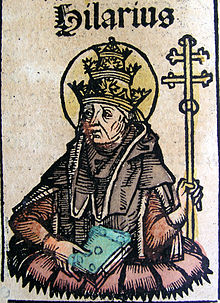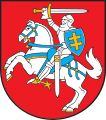Patriarchal Cross

Patriarchal Cross , Hungarian Cross , Slovak Cross or Spanish Cross , is the name of a double cross. It consists of a vertical bar with two transverse bars, the upper one being shorter than the lower one. The cross symbolizes on the one hand ecclesiastical archbishopric and metropolitan authority , on the other hand it is a centuries-old symbol in Hungary , Lithuania and Slovakia .
The upper, shorter crossbar symbolizes the inscription INRI on the cross of Jesus Christ , the Latin cross . The double cross has spread from the Orient across Europe since the 6th century. The double cross found widespread use in the 10th century in the Byzantine Empire, from which the name Byzantine double cross is derived.
Similarities and derivations
The patriarchal cross ![]() is similar to the Lorraine cross
is similar to the Lorraine cross ![]() with mostly, but not always the same length cross arms. The patriarchal cross, however, is always derived from the Latin cross and has its crossbars consistently above the center, whereas the Lorraine cross is symmetrical in essence upwards and downwards. A special feature is the use of the patriarchal cross as a Lorraine cross by de Gaulle in the Second World War by the Free French Armed Forces (e.g. seen in the Ordre de la Liberation ). The Hungarian form and its relatives are very similar to the Lorraine form; History, use and symbolic meaning, however, are different.
with mostly, but not always the same length cross arms. The patriarchal cross, however, is always derived from the Latin cross and has its crossbars consistently above the center, whereas the Lorraine cross is symmetrical in essence upwards and downwards. A special feature is the use of the patriarchal cross as a Lorraine cross by de Gaulle in the Second World War by the Free French Armed Forces (e.g. seen in the Ordre de la Liberation ). The Hungarian form and its relatives are very similar to the Lorraine form; History, use and symbolic meaning, however, are different.
With a further bar it represents the Pope's cross ![]() , with an additional lower sloping bar the cross of the Russian Orthodox Patriarchs
, with an additional lower sloping bar the cross of the Russian Orthodox Patriarchs ![]() .
.
The patriarchal cross, like many basic crosses, has numerous end shapes, such as pawed ![]() or with a clover leaf .
or with a clover leaf .
The double-armed cross also serves as:
- Outwardly visible sign as a reference and symbol of metropolitan churches (often as the end of the highest church tower, see Vienna).
- In the coat of arms of the metropolitans (real archbishops, but also the titular archbishops).
- Also for centuries the double cross on church buildings has been the visible symbol for the exemption of these - of course also of the church organizations, i.e. the orders, ie the monasteries and monasteries - from the respective episcopal jurisdiction of the diocesan bishop.
Annotation:
As a special sign that the Dominicans and later the Jesuits are directly responsible to the Pope and only to the Pope, the pedum rectum, i.e. the triple Pope's cross, i.e. the exact shepherd's crook, adorns the respective church buildings (example: Jesuits in Kalksburg near Vienna) .
history
Byzantine Empire
The first illustration of a cross with two crossbars is said to have been found in the city of Chersonese in the Crimea . In the 10th century this form was widespread in the Byzantine Empire .
Hungary
A cross with two bars of different lengths ![]() is a letter in the old Hungarian alphabet (runic script). Under King Stephen I (1000-1031) the "Hungarian Cross" was struck on coins and has been a symbol of the Kingdom of Hungary ever since.
is a letter in the old Hungarian alphabet (runic script). Under King Stephen I (1000-1031) the "Hungarian Cross" was struck on coins and has been a symbol of the Kingdom of Hungary ever since.
Order of the Holy Spirit

The brothers of the Order of the Holy Spirit and their Holy Spirit hospitals , who were directly subordinate to the Pope, wore the patriarchal cross on their habitats and used it as a coat of arms on buildings and boundary stones.
coat of arms
Places in Germany

Some municipalities dominated by Heilig-Geist-Hospitals have adopted the cross in their municipal coat of arms; for example Bissingen and Hochdorf an der Enz in the Ludwigsburg district , which bear the coat of arms of the Grüninger Heilig-Geist-Spital .
Bad Hersfeld and Philippsthal (Werra) use the Hersfeld double cross (see district Hersfeld-Rotenburg / district Hersfeld ) and the district Pfaffenhofen an der Ilm shows the double cross of the monstrance of Scheyern monastery.
countries
Coat of arms of Belarus (from 1991 to 1995)
Slovakia
The so-called "Byzantine double cross" is said to have brought the saints Cyril and Methodius to Greater Moravia, i.e. the area of today's Slovakia, the Czech Republic and Hungary, as early as the 9th century. Later in the Middle Ages, the double cross temporarily stood for the Principality of Neutra and for northern parts of the Kingdom of Hungary ( known as Upper Hungary since the 18th / 19th centuries ), roughly equivalent to the area of today's Slovakia. This is one of the reasons why it has officially been used as the coat of arms of Slovakia (then initially of the Slovak National Council ) since 1848 . The only difference to the new coat of arms is the lack of the crown and the use of the Slavic colors blue- white-red instead of the Hungarian green- white-red. The Slovak coat of arms, designed by Ivan Řehák , can be seen on the Slovak 1 and 2 euro coins .
Lithuania
The Hungarian / Slovak double cross - resembling the Lorraine cross - also made its way into the coat of arms of Lithuania through the Jagiellonian family when it was adopted by Władysław II Jagiełło in 1386 as the alleged cross of St. Ladislaus .
Hungary
The "new" coat of arms of Hungary , which was used here in the years 1867–1890, shows a silver (white) double cross on three green hills and a crown with a red background. The double cross dates from the 9th century, the three mountains ( Tátra , Fátra , Mátra ) from the early 14th century, and the crown under the cross was added at the beginning of the 17th century. At the time of Pope Sylvester II, the first Christian king of Hungary, Stephen the Holy, integrated the double cross into the royal badges in 1000 on March 27th. The cross stood for the apostolic dignity of the Hungarian king.
Belarus
Because the history of Belarus is closely related to the history of Lithuania and both states formed the Grand Duchy of Lithuania , a similarity between the coats of arms can be seen. The coat of arms of Belarus , introduced in 1991 and abolished in 1995, shows a rider with a shield on which a patriarchal cross is depicted.
Medals
The patriarchal cross was seldom used for medals. The only exception are three religious foundations of the short-lived first Slovak Republic , which existed from 1939 to 1945: the Order of the Slovak Cross (also Hlinkaorden named because it is the portrait of Andrej Hlinka was donated in 1940). The patriarchal cross also appears as an element in the medal and the collar of the Prince Pribina order (named after Prince Pribina ), as well as in the war victory order of Slovakia.
The patriarchal cross appears as an element in religious symbols in the Collane of the Swedish Order of the Seraphines and in the Hungarian orders from the time of Miklós Horthy : the Order of the Golden Spur (1918) and the Hungarian Order of Merit (1922).
In the last two cases, the use of the patriarchal cross goes back to the presence of the cross in the Slovak and Hungarian national coats of arms .
The patriarchal cross was also used as a symbol by the 30th Waffen Grenadier Division of the SS (Belarusian No. 1) and the 30th Waffen Grenadier Division of the SS (Russian No. 2) .
Characters
In Unicode is in the block " Miscellaneous Symbols " as U + 2628 cross of lorraine one character whose code tables used in the glyph actually rather the patriarchal cross as the Cross of Lorraine equivalent.
literature
- Gisela Drossbach: Christian Caritas as a legal institution. Hospital and order of Santo Spirito in Sassia (1198-1378) (= canon and state church law. Vol. 2). Schöningh, Paderborn et al. 2005, ISBN 3-506-71766-9 , (at the same time: Dresden, Technical University, habilitation paper, 2002; digitized version (BSB) ).
- Arnhard Graf Klenau: European medals from 1700. Catalog. Without Germany. Klenau, Fridingen 1978, ISBN 3-921566-05-3 .
Web links
Individual evidence
- ↑ Gerhard Rimmele in the coat of arms history of the community Illerkirchberg on http://www.rimuki.de on April 1, 2002 .
- ↑ Seal of the governor of Chersonese, cf. History of the Cross Shapes ( Memento of the original from January 26, 2010 in the Internet Archive ) Info: The archive link was inserted automatically and has not yet been checked. Please check the original and archive link according to the instructions and then remove this notice. (Russian).
- ↑ The Grüninger Holy Spirit Hospital were Kilianskirche in Bissingen and St. Peter's in Bietigheim subordinate. This hospital had extensive property in Hochdorf. See Petra Schad (Red.): 700 years of the Heilig-Geist-Spital Markgröningen. City of Markgröningen, Markgröningen 1997, ISBN 3-929948-06-0 .
- ↑ Code Tables - Miscellaneous Symbols. (PDF; 368 kB) Unicode Consortium, accessed on August 3, 2012 .







